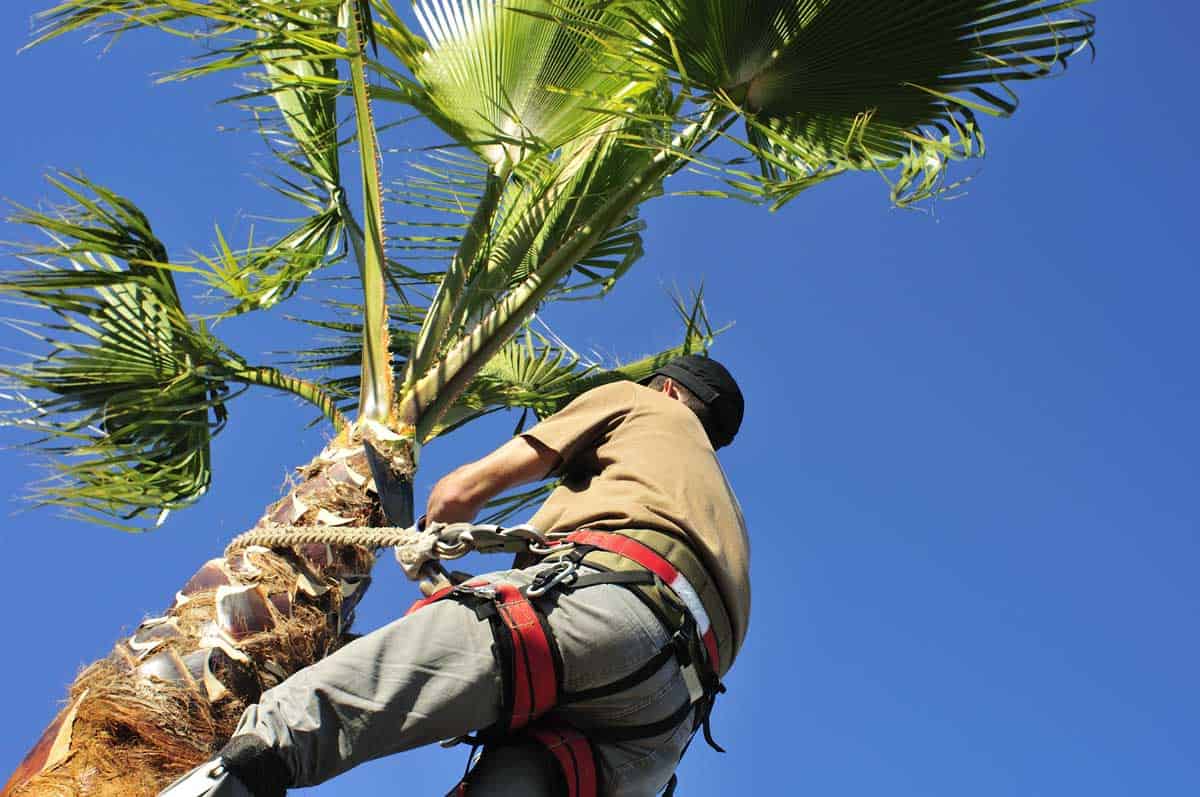Palm trees add a tropical look and feel to your home indoors and in outdoor gardens. Overall, palm trees are pretty low maintenance, but there are occasions when you may need to give a palm tree a trim. But, have you ever wondered how to trim a palm tree, what tools you might need, or when to call a professional for assistance? We researched various sources about how to safely and adequately trim a palm tree and signs that your palm tree could use some maintenance.

Here are the steps you need to take if you want to trim a palm tree -
- Look over your palm for brown fronds.
- Clean your pruning shears (or an extended pole saw for tall palms).
- Remove dead fronds without harming the trunk, avoiding the crown head.
For tall trees, or if you're unsure of how to cut the tree, call a professional.
Indoor palms that are small and more manageable are easy to trim and care for, but larger palms may require hiring a professional. Read on and gain the confidence you need to best care for your palm tree's health and appearance.
Uncover the Needs of Your Palm Tree
Luckily, most palm trees are relatively low-maintenance plants that thrive when grown outdoors or indoors, depending on the species. Although palm trees can live up to a century, they still require routine maintenance to keep them healthy, beautiful, and growing skyward. There are more than a few reasons it may become necessary to give a palm tree a trim.
Old Discolored Fronds
There is no greater eyesore in an outdoor garden than walking or driving past and witnessing a distressed-looking palm tree covered in dead, brown, discolored fronds. It is not only visually unattractive to neglect to prune old fronds that are no longer green and healthy, but they add extra weight to a palm tree, further stressing the plant.
Aesthetic Appeal

It is essential not to over prune a palm tree, as they only need maintenance an average of once or twice a year. However, there are moments when a gardener shouldn't wait any longer to trim that palm. Remember to make sure a palm frond is entirely dead before removing it and be mindful of being overzealous with pruning shears or a saw.
Fire Hazard
Palm trees that have dried leaves hanging around are not only an eyesore, but they can lead to fires. If a palm tree is growing in a place that gets incredibly hot and has high windows, anything that can catch on fire should be removed as soon as possible. A flaming palm tree ignited because of areas that experience fire season or a lightning strike can easily ignite nearby structures, plants, and damage property.
Vermin
Especially in states like Florida, palm rats can be a severe problem if you love growing palm trees outdoors. An unkempt palm tree that needs a trim may be a haven for rats. Palm trees that are a mass of dead hanging fronds, or have a hollowed-out trunk provide a nest for vermin looking to make a home.
Seasonal Trim

Spring is the best time to prune a palm tree, as fronds should be allowed to hang on a palm tree during the summer and wintertime to protect the tree from extreme temperatures. Unless the fronds of a palm tree are dead, brown, a hazard, or diseased, it is not necessary to prune a palm. Removing the fronds of a palm more than once a year can lead to a weakened plant and retard growth.
How Do I Trim a Palm Tree?
Before you tackle the task of trimming a palm tree, you need to have the right tools for the job first. Small indoor palm trees can be pruned easily with a pair of bypass pruners or loopers. A more massive palm may require calling for professional help if you are short on time or uncomfortable with pruning your palm tree. You may need to don climbing gear or climb a ladder to reach fronds. A clean cutting saw should be used to trim palms that have dead fronds, or diseased and damaged sections, leaving only healthy parts of the tree behind.
Trimming a small indoor palm is pretty straightforward. However, here are the steps to prune a sizeable outdoor palm tree safely.
- Make sure your tools are clean and sterilized to prevent transmission of disease to your plant. Use a solution of bleach and water with a 1 to 3 ratio.
- Cut or saw fronds close to the trunk without damaging the trunk, and only if the fronds are not at a 90-degree angle.
- Use an extension ladder or put on climbing gear to reach high areas of a palm tree over 15 feet.
- Looping shears can be used to prune a palm tree, but a linoleum knife helps remove boots on a trunk that do not fall off.
- Don't remove yellow fronds and only remove fronds that are brown, dead, and falling downward. Keeping this in mind helps the palm retain nutrients and stay strong and healthy.
Take your time when pruning a palm tree and carefully look over your plant to check for disease, fungus, signs of vermin, or other problems. If you do not feel confident enough to prune a palm do call a professional to provide maintenance services for your plants.
When Should Palm Trees be Trimmed?
A palm tree should be trimmed in the springtime, but also before hurricane or fire season starts. Dead fronds and boots left hanging on a tree can lead to property damage if blown about by strong winds, or if the tree becomes ignited.
What is the Best Tool to Trim Palm Trees?
The best tool to trim a palm tree if it is small is a set of bypass pruning shears. If you are cutting an outdoor palm tree that is over 15 feet tall, you will want to use a pole saw to reach hard to get areas.
Check out this pole saw and chainsaw combo on Amazon.
Check out this set of pruning shears on Amazon.
Should You Trim a Palm Tree on Your Own?
If you wish to trim a palm tree on your own using climbing gear, it is best to avoid using spikes, which can damage the trunk as you shimmy up the tree. It is better to rent a lift or use an extendable ladder to get to high places in a palm tree without causing unnecessary damage or hire a professional to examine and prune your tree.
Check out this tree-climbing set on Amazon.
How Much Does it Cost to Trim a Palm Tree?
The cost of having a palm tree trimmed depends on the tree's height if it is an emergency call, and the condition of your palm. Trees that are taller or are in poor health are more expensive to trim because of the extensive amount of time needed to perform proper maintenance and care. Palms that are 30 feet or smaller may cost as little as $75 and as much as $400 to trim. Trees towering 60 feet or higher may cost between $200 and $1200 for professional maintenance.
Homeowners can prepare to spend between $80 and $1200 to have their palm trees trimmed depending on the number of trees that need attention, accessibility issues, and the height, width, condition, and location of the trees in question. The national average cost to have a tree trimmed or removed is $693.
Should I Cut Off Brown Palm Leaves?
![Dry tropical palm leaves on a dead palm tree, How To Tell If a Palm Tree is Dead? [And How To Revive It]](https://gardentabs.com/wp-content/uploads/2020/07/Dry-tropical-palm-leaves-on-a-dead-palm-tree.jpg)
Remove brown palm leaves, especially if they no longer sit on the palm at a 90-degree angle or higher, or they are dried out. Palm leaves that are alive and healthy are vibrant green and become yellow and then brown as they die.
What Happens When You Cut the Top Off a Palm Tree?
It is not advisable to cut off the top of a palm tree or the crown head. The crown head is responsible for the palm tree's growth and continual existence, and a palm tree will soon perish after you remove the top.
Click here to read more fascinating articles about palm trees.




Thanks for the great information. Anyway, how tough are the fronds of a palm tree? Is it practical to trim them with a hand saw?
What tools are needed?
Thanks for the great information.